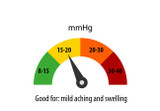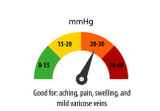Compression socks are designed to increase the blood flow in a person's legs. But depending on the level of compression, they can treat more specific issues. Compression level refers to the strength or tightness of the stocking. The level of strength is measured by mmHg, also known as millimeters of mercury. The higher the mmHg, the greater the compression. These pressure stockings fall into one of four categories: 8-15 mmHg, 15-20 mmHg, 20-30 mmHg, and 30-40 mmHg. Each compression level treats different issues. Be sure to consult with your doctor to figure out which compression level is right for you.
8-15 mmHg are the most mild stockings we carry. They provide light compression, which treats minor issues. For example, if you experience frequent tired or achy legs, this compression level can help energize the legs. They are also ideal for people who sit or stand for extended periods of time, as they prevent leg fatigue. They're also great for people with mild swelling in the feet, ankles, or legs.
The next level up in firmness is 15-20 mmHg, which provides moderate compression. These medical stockings are great to use when traveling long distances, as they help reduce swelling. They prevent varicose veins and spider veins during pregnancy. 15-20 mmHg socks are also effective at preventing deep vein thrombosis, also known as DVT.
20-30 mmHg stockings are considered firm pressure. One of the most common reasons for wearing this stocking level is to prevent or relieve moderate spider veins or varicose veins. Firm compression stockings can help reduce excess fluid build up in the legs or feet, referred to as edema. These stockings can also help prevent orthotic hypotension, which is the rapid drop in blood pressure after standing up.
30-40 mmHg stockings provide extra firm pressure to the legs. They are often used to treat more severe cases of edema and lymphedema. These compression socks also help manage conditions like post thrombotic syndrome as well as venous ulcers. 30-40 mmHg stockings are often recommended to people who have undergone surgery or sclerotherapy treatment.
















